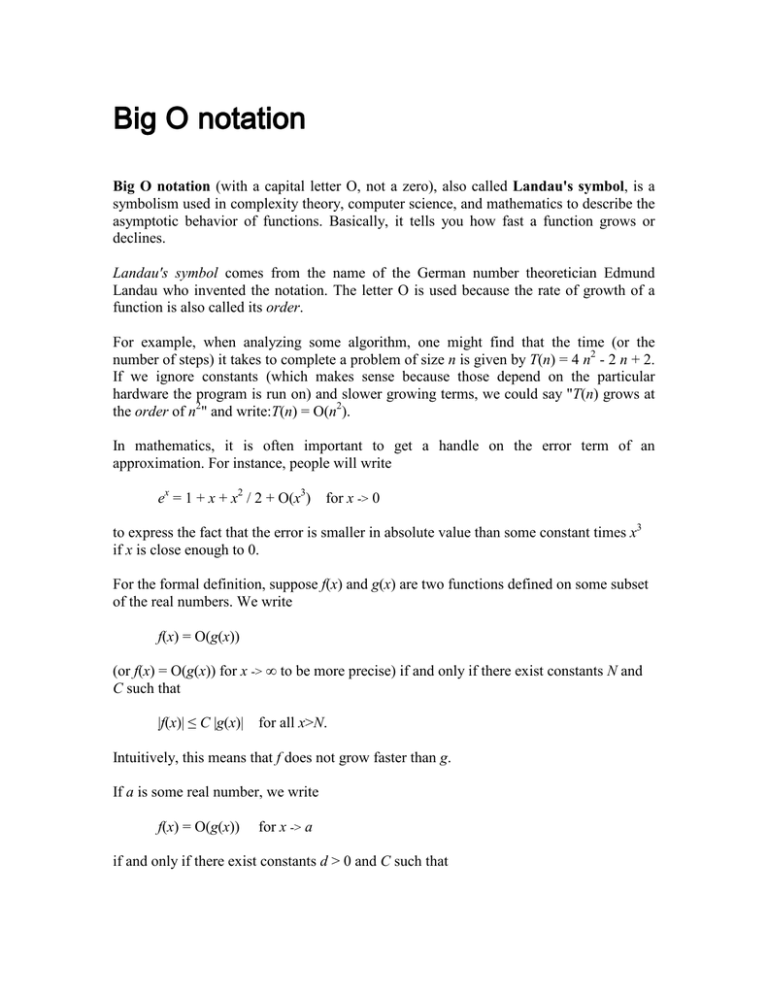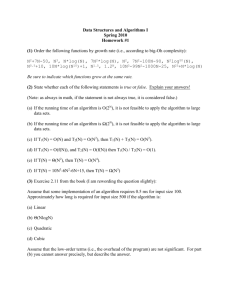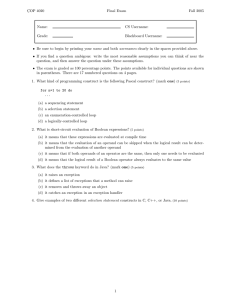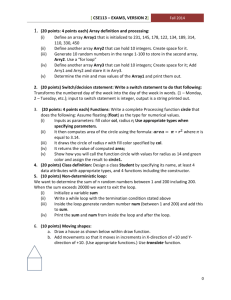Big O notation
advertisement

Big O notation (with a capital letter O, not a zero), also called Landau's symbol, is a symbolism used in complexity theory, computer science, and mathematics to describe the asymptotic behavior of functions. Basically, it tells you how fast a function grows or declines. Landau's symbol comes from the name of the German number theoretician Edmund Landau who invented the notation. The letter O is used because the rate of growth of a function is also called its order. For example, when analyzing some algorithm, one might find that the time (or the number of steps) it takes to complete a problem of size n is given by T(n) = 4 n2 - 2 n + 2. If we ignore constants (which makes sense because those depend on the particular hardware the program is run on) and slower growing terms, we could say "T(n) grows at the order of n2" and write:T(n) = O(n2). In mathematics, it is often important to get a handle on the error term of an approximation. For instance, people will write ex = 1 + x + x2 / 2 + O(x3) for x -> 0 to express the fact that the error is smaller in absolute value than some constant times x3 if x is close enough to 0. For the formal definition, suppose f(x) and g(x) are two functions defined on some subset of the real numbers. We write f(x) = O(g(x)) (or f(x) = O(g(x)) for x -> C such that |f(x)| to be more precise) if and only if there exist constants N and C |g(x)| for all x>N. Intuitively, this means that f does not grow faster than g. If a is some real number, we write f(x) = O(g(x)) for x -> a if and only if there exist constants d > 0 and C such that |f(x)| C |g(x)| for all x with |x-a| < d. The first definition is the only one used in computer science (where typically only positive functions with a natural number n as argument are considered; the absolute values can then be ignored), while both usages appear in mathematics. Here is a list of classes of functions that are commonly encountered when analyzing algorithms. The slower growing functions are listed first. c is some arbitrary constant. notation name O(1) constant O(log(n)) logarithmic c O((log(n)) ) polylogarithmic O(n) linear O(n2) quadratic c O(n ) polynomial O(cn) exponential Note that O(nc) and O(cn) are very different. The latter grows much, much faster, no matter how big the constant c is. A function that grows faster than any power of n is called superpolynomial. One that grows slower than an exponential function of the form cn is called subexponential. An algorithm can require time that is both superpolynomial and subexponential; examples of this include the fastest algorithms known for integer factorization. Note, too, that O(log n) is exactly the same as O(log(nc)). The logarithms differ only by a constant factor, and the big O notation ignores that. Similarly, logs with different constant bases are equivalent. The above list is useful because of the following fact: if a function f(n) is a sum of functions, one of which grows faster than the others, then the faster growing one determines the order of f(n). Example: If f(n) = 10 log(n) + 5 (log(n))3 + 7 n + 3 n2 + 6 n3, then f(n) = O(n3). One caveat here: the number of summands has to be constant and may not depend on n. This notation can also be used with multiple variables and with other expressions on the right side of the equal sign. The notation: f(n,m) = n2 + m3 + O(n+m) represents the statement: ∃C ∃ N ∀ n,m>N : f(n,m) n2+m3+C(n+m) Obviously, this notation is abusing the equality symbol, since it violates the axiom of equality: "things equal to the same thing are equal to each other". To be more formally correct, some people (mostly mathematicians, as opposed to computer scientists) prefer to define O(g(x)) as a set-valued function, whose value is all functions that do not grow faster then g(x), and use set membership notation to indicate that a specific function is a member of the set thus defined. Both forms are in common use, but the sloppier equality notation is more common at present. Another point of sloppiness is that the parameter whose asymptotic behaviour is being examined is not clear. A statement such as f(x,y) = O(g(x,y)) requires some additional explanation to make clear what is meant. Still, this problem is rare in practice. In addition to the big O notations, another Landau symbol is used in mathematics: the little o. Informally, f(x) = o(g(x)) means that f grows much slower than g and is insignificant in comparison. Formally, we write f(x) = o(g(x)) (for x -> ) if and only if for every C>0 there exists a real number N such that for all x > N we have |f(x)| < C |g(x)|; if g(x) 0, this is equivalent to limx f(x)/g(x) = 0. Also, if a is some real number, we write f(x) = o(g(x)) for x -> a if and only if for every C>0 there exists a positive real number d such that for all x with |x - a| < d we have |f(x)| < C |g(x)|; if g(x) 0, this is equivalent to limx -> a f(x)/g(x) = 0. Big O is the most commonly-used of five notations for comparing functions: Notation Definition f(n) = O(g(n)) see above f(n) = o(g(n)) see above < f(n) = (g(n)) g(n)=O(f(n)) f(n) = (g(n)) g(n)=o(f(n)) > f(n)=O(g(n)) and g(n)=O(f(n)) = f(n) = (g(n)) Analogy The notations and are often used in computer science; the lowercase o is common in mathematics but rare in computer science. The lowercase is rarely used. A common error is to confuse these by using O when is meant. For example, one might say "heapsort is O(n log n)" when the intended meaning was "heapsort is (n log n)". Both statements are true, but the latter is a stronger claim. The notations described here are very useful. They are used for approximating formulas for analysis of algorithms, and for the definitions of terms in complexity theory (e.g. polynomial time). How efficient is an algorithm or piece of code? Efficiency covers lots of resources, including: • • • • CPU (time) usage memory usage disk usage network usage All are important but we will mostly talk about time complexity (CPU usage). Be careful to differentiate between: 1. Performance: how much time/memory/disk/... is actually used when a program is run. This depends on the machine, compiler, etc. as well as the code. 2. Complexity: how do the resource requirements of a program or algorithm scale, i.e., what happens as the size of the problem being solved gets larger? Complexity affects performance but not the other way around. The time required by a function/procedure is proportional to the number of "basic operations" that it performs. Here are some examples of basic operations: • • • • • one arithmetic operation (e.g., +, *). one assignment (e.g. x := 0) one test (e.g., x = 0) one read (of a primitive type: integer, float, character, boolean) one write (of a primitive type: integer, float, character, boolean) Some functions/procedures perform the same number of operations every time they are called. For example, StackSize in the Stack implementation always returns the number of elements currently in the stack or states that the stack is empty, then we say that StackSize takes constant time. Other functions/ procedures may perform different numbers of operations, depending on the value of a parameter. For example, in the BubbleSort algorithm, the number of elements in the array, determines the number of operations performed by the algorithm. This parameter (number of elements) is called the problem size/ input size. When we are trying to find the complexity of the function/ procedure/ algorithm/ program, we are not interested in the exact number of operations that are being performed. Instead, we are interested in the relation of the number of operations to the problem size. Typically, we are usually interested in the worst case: what is the maximum number of operations that might be performed for a given problem size. For example, inserting an element into an array, we have to move the current element and all of the elements that come after it one place to the right in the array. In the worst case, inserting at the beginning of the array, all of the elements in the array must be moved. Therefore, in the worst case, the time for insertion is proportional to the number of elements in the array, and we say that the worst-case time for the insertion operation is linear in the number of elements in the array. For a linear-time algorithm, if the problem size doubles, the number of operations also doubles. We express complexity using big-O notation. For a problem of size N: a constant-time algorithm is "order 1": O(1) a linear-time algorithm is "order N": O(N) a quadratic-time algorithm is "order N squared": O(N2) Note that the big-O expressions do not have constants or low-order terms. This is because, when N gets large enough, constants and low-order terms don't matter (a constant-time algorithm will be faster than a linear-time algorithm, which will be faster than a quadratic-time algorithm). Formal definition: A function T(N) is O(F(N)) if for some constant c and for values of N greater than some value n0: T(N) <= c * F(N) The idea is that T(N) is the exact complexity of a procedure/function/algorithm as a function of the problem size N, and that F(N) is an upper-bound on that complexity (i.e., the actual time/space or whatever for a problem of size N will be no worse than F(N)). In practice, we want the smallest F(N) -- the least upper bound on the actual complexity. For example, consider: T(N) = 3 * N2 + 5. We can show that T(N) is O(N2) by choosing c = 4 and n0 = 2. This is because for all values of N greater than 2: 3 * N2 + 5 <= 4 * N2 T(N) is not O(N), because whatever constant c and value n0 you choose, There is always a value of N > n0 such that (3 * N2 + 5) > (c * N) In general, how can you determine the running time of a piece of code? The answer is that it depends on what kinds of statements are used. Sequence of statements statement 1; statement 2; ... statement k; The total time is found by adding the times for all statements: total time = time(statement 1) + time(statement 2) + ... + time(statement k) If each statement is "simple" (only involves basic operations) then the time for each statement is constant and the total time is also constant: O(1). If-Then-Else if (cond) then block 1 (sequence of statements) else block 2 (sequence of statements) end if; Here, either block 1 will execute, or block 2 will execute. Therefore, the worst-case time is the slower of the two possibilities: max(time(block 1), time(block 2)) If block 1 takes O(1) and block 2 takes O(N), the if-then-else statement would be O(N). Loops for I in 1 .. N loop sequence of statements end loop; The loop executes N times, so the sequence of statements also executes N times. If we assume the statements are O(1), the total time for the for loop is N * O(1), which is O(N) overall. Nested loops for I in 1 .. N loop for J in 1 .. M loop sequence of statements end loop; end loop; The outer loop executes N times. Every time the outer loop executes, the inner loop executes M times. As a result, the statements in the inner loop execute a total of N * M times. Thus, the complexity is O(N * M). instead In a common special case where the stopping condition of the inner loop is of (i.e., the inner loop also executes N times), the total complexity for the two loops 2 is O(N ). Statements with function/ procedure calls When a statement involves a function/ procedure call, the complexity of the statement includes the complexity of the function/ procedure. Assume that you know that function/ procedure f takes constant time, and that function/procedure g takes time proportional to (linear in) the value of its parameter k. Then the statements below have the time complexities indicated. f(k) has O(1) g(k) has O(k) When a loop is involved, the same rule applies. For example: for J in 1 .. N loop g(J); end loop; has complexity (N2). The loop executes N times and each function/procedure call complexity O(N). is




